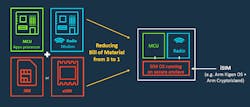Arm’s recent purchase of Simulity is already bearing fruit in the form of iSIM. This puts the subscriber identity module (SIM) functionality for cellular systems into a system-on-chip (SoC) that would include other ARM processors (Fig. 1). The iSIM hardware is a small fraction of the SoC compared to the earlier SIM cards that would probably be larger than the entire SoC. It targets SoCs for the embedded Internet of Things (IoT).
1. The iSIM hardware is designed to bring secure authentication support to a cellular SoC.
SIM cards have been in use for 25 years in cellphones and cellular devices. They provide a unique ID and the hardware and firmware to authenticate a device within a cellular network.
The complementary firmware for iSIM is Arm’s Kigen operating system (OS). This is a secure, GSMA-compliant SIM OS. The code is optimized for compactness while maintaining implementation flexibility. The SIM OS is designed to run in the Secure Enclave (SE) environment that Arm provides for secure SoCs (Fig. 2). The SE is an isolated piece of hardware that handles security services like system authentication. Combining all the components into a single chip reduces costs while improving reliability, power efficiency, and size.
2. The SIM OS runs on the iSIM hardware within Arm’s Secure Enclave.
The iSIM-based devices are designed to work with Arm’s server-based Kigen solution as well as any GSMA-compliant system. The Kigen Server supports GSMA-compliant SIM provisioning. It is designed for easy integration with mobile operator networks and IoT server platforms using SOAP and REST APIs. This helps to provide cellular IoT devices with secure, over-the-air (OTA) updates.
A trillion IoT devices are expected by 2021 and many of these will be based on cellular technology. Arm is banking that many will incorporate iSIM and Kigen SIM OS. The SIM technology will be compatible with the forthcoming 5G networks, but it is already compatible with existing 4G/LTE networks.



